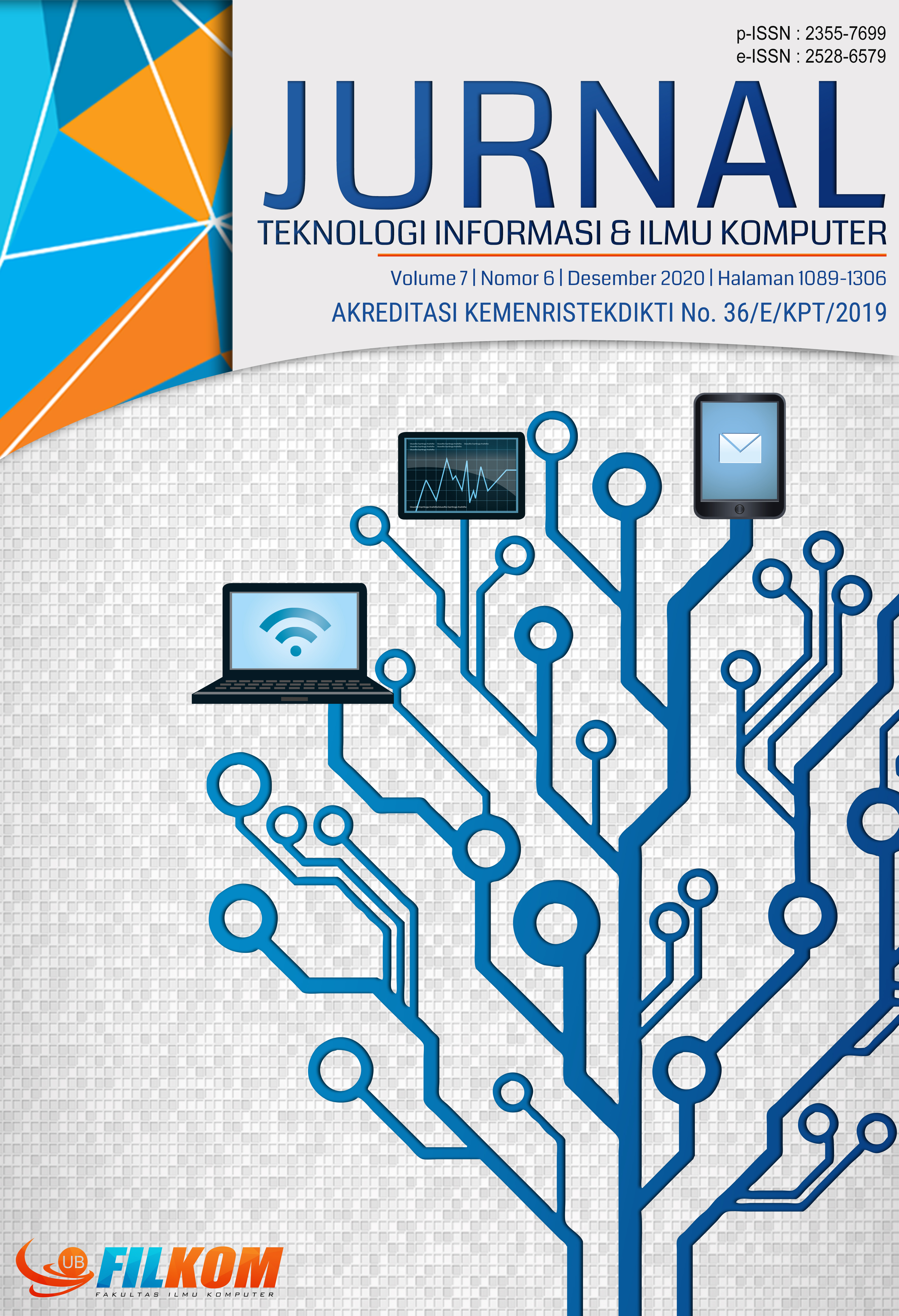Penerapan Hidden Markov Model (HMM) dan Mel-Frequency Cesptral Coefficients (MFCC) pada E-Learning Bahasa Madura untuk Anak Usia Dini
DOI:
https://doi.org/10.25126/jtiik.2020722477Abstrak
Bahasa Madura is a regional language used in Madura island. This language has many variations of pronunciation and dialect that makes it not easy to learn, even by the local people especially children. There hasn’t been any interesting learning media to learn Bahasa Madura so far. In fact, a fun learning activity is needed to help children to enhance their ability in pronouncing animals’ names, numbers, fruits and things in Bahasa Madura. Thus, it’s considered important to create Bahasa Madura e-learning by implementing the recognition of voice patterns in order to make it easier for the children to learn Bahasa Madura which has several variations of pronunciation only for one single object. This Bahasa Madura e-learning application for young learners is used to introduce Bahasa Madura vocabularies by recognizing the voice pattern recordings which have been processed through MFCC technique as the extracted voice features and HMM as the learning techniques. The implementation of MFCC and HMM as the learning tool to introduce the pronunciation of regional language vocabularies especially Bahasa Madura has never been done before. Therefore, this research is expected to help the young learners to be able to pronounce Bahasa Madura vocabularies properly. In this study, a number of young learners’ voices were recorded and were set as the trial data. Only the proper voice data that were used—voice data that were considered to be pronounced correctly. The trial method was done through one-single model and multi-model. After doing several simultaneous trials, the result showed the accuracy level. The average accuracy level for one-single model system was 73% (with the highest accuracy reached 75%) and the average accuracy level for multi-model system was 80% (with the highest accuracy reached 81%).Downloads
Referensi
ABDULLA, W. H., CHOW, D., & SIN, G., 2003. Cross-words reference template for DTW-based speech recognition systems. In TENCON 2003. Conference on Convergent Technologies for the Asia-Pacific Region, Vol.4, pp. 1576-1579.
CANTIKA, P.D., B. HERMANTO., 2018. Rancang Bangun Aplikasi E-learning Untuk Pembelajaran Agama Islam Berbasis Android (Studi Kasus MIN 6 Bandar Lampung). Jurnal Komputasi, 6(1), pp. 25-32.
DESHMUKH S.D., BACHUTE, M.R., 2013. Automatic Speech and Speaker Recognition by MFCC, HMM and Vector Quantization. International Journal of Engineering and Innovative Technology (IJEIT), 3(1), pp.109-113.
DEWI, N.P., I. LISTIOWARNI., 2019. Implementasi Game Based Learning pada Pembelajaran Bahasa Inggris. Jurnal Resti, 3(2), pp.124-130.
FUENTES, R., JAVIER, L., TORRES, M., 2003. Comparative Study of the Baum-Welch and Viterbi Training Algorithms Applied to Read and Spontaneous Speech Recognition, pp 847 – 857.
GUPTA, S., JAAFAR, J., AHMAD, W.F.W., & BANSAL, A., 2013. Feature Extraction Using MFCC. Signal & Image Processing : An International Journal (SIPIJ), 4(4), pp. 101-108.
IBRAHIM, Y.A., ODIKETA, J.C., IBIYEMI, T.S., 2017. Preprocessing Technique In Automatic Speech Recognition for Human Computer Interaction: An Overview. Annals Computer Science Series, 15(1), pp.186-191.
IQBAL, S., MAHBOOB, T., KHIYAL, M.S.H., 2011. Voice Recognition using HMM with MFCC for Secure ATM. IJCSI International Journal of Computer Science Issues, 8(3), pp. 297-303.
MEHTA, L. R., DABHADE, A. S., 2013. Comparison Study of MFCC and LPC for Marathi Isolated Word. Int. J. Adv. Res. Electr. Electron. Instrum. Eng., 2(6), pp. 2133–2139.
MON, S.M., TUN, H.M., 2015. Speech-To-Text Conversion STT System Using Hidden Markov Model HMM. International Journal of Scientific & Technology Research, 4(6), pp. 349-352(4).
MUSTOFA, A., 2007. Sistem Pengenalan Penutur dengan Metode Mel-frequency Wrapping. Jurnal Teknik Elektro,7(2), pp. 88 – 96.
NAZIYA, S., DESHMUKH, S.D., 2015. Speech Recognition System – A Review IOSR Journal of Computer Engineering (IOSR-JCE), 18(4), pp.01-09.
PANCHAL, J.R., 2010. Linear Predictive Coding For Speech Signal Feature Extraction. Thesis. California State University, Sacramento.
PERMANA, A.F., 2011. Implementasi Hidden Markov Model Untuk Aplikasi Pengenalan Ucapan Sebagai Kendali Gerak Robot Mobil.Tugas Akhir. Institut Pertanian Bogor.
PRASETIO, B.H., KURNIAWAN, W., ICHSAN, M.H.H., 2017. Pengenalan Emosi Berdasarkan Suara menggunakan Algoritma HMM. Jurnal Teknologi Informasi dan Ilmu Komputer (JTIIK), 4(3), pp.168-172.
SAHA, G., CHAKROBORTY, S., SENAPATI, S. 2014. A New Silence Removal and Endpoint Detection Algorithm for Speech and Speaker Recognition Applications, IJIGSP, pp. 1-5.
SANJAYA, W.S.M., SALLEH, Z., 2014. Implementasi Pengenalan Pola Suara Menggunakan Mel_Frequency Cepstrum Coefficients (MFCC) dan Adaptive Neuro-Fuzzy Inferense System (ANFIS) sebagai Kontrol Lampu Otomatis, Al-Hazen Journal of Physics, 1(1), pp.44-54.
SANJAYA, W.S.M., 2017. Robot Cerdas Berbasi Speech Recognition. Yogyakarta: ANDI.
SOFYAN, A., 2007. Dialek dan Tingkat Tutur dalam Bahasa Madura. Jurnal Medan Bahasa, Vol.1 No.1.
SOFYAN, A., 2017. Tata Bahasa Bahasa Madura. Sidoarjo: Bahasa Surabaya.
TIWARI, V., 2010. MFCC and Its Applications in Speaker Recognition.Int. J. Emerg. Technol., 1(1), pp. 19–22.
YUNDATAMA, Y., PARNO. 2015. E-learning English for Children Aplikasi Mobile Mengenal Alat Transportasi Berbasis Android. Prosiding PESAT (Psikologi, Ekonomi, Sastra, Arsitektur &Teknik Sipil), Vol. 6, pp.134-141.
Unduhan
Diterbitkan
Terbitan
Bagian
Lisensi

Artikel ini berlisensi Creative Common Attribution-ShareAlike 4.0 International (CC BY-SA 4.0)
Penulis yang menerbitkan di jurnal ini menyetujui ketentuan berikut:
- Penulis menyimpan hak cipta dan memberikan jurnal hak penerbitan pertama naskah secara simultan dengan lisensi di bawah Creative Common Attribution-ShareAlike 4.0 International (CC BY-SA 4.0) yang mengizinkan orang lain untuk berbagi pekerjaan dengan sebuah pernyataan kepenulisan pekerjaan dan penerbitan awal di jurnal ini.
- Penulis bisa memasukkan ke dalam penyusunan kontraktual tambahan terpisah untuk distribusi non ekslusif versi kaya terbitan jurnal (contoh: mempostingnya ke repositori institusional atau menerbitkannya dalam sebuah buku), dengan pengakuan penerbitan awalnya di jurnal ini.
- Penulis diizinkan dan didorong untuk mem-posting karya mereka online (contoh: di repositori institusional atau di website mereka) sebelum dan selama proses penyerahan, karena dapat mengarahkan ke pertukaran produktif, seperti halnya sitiran yang lebih awal dan lebih hebat dari karya yang diterbitkan. (Lihat Efek Akses Terbuka).












